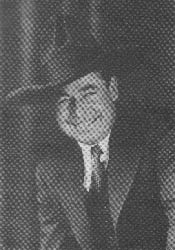|
Riverside, CA was the home of two airfields significant to Register signers. Military pilots frequented March Field. Civil pilots used the small field, the Riverside Municipal Airport, developed by local cowboy Roman Warren, left.
March Field, 1931 (Source: Webmaster)
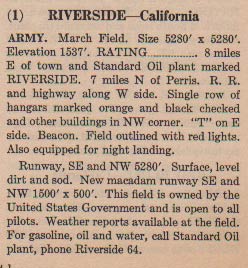 |
MARCH FIELD
March Field was a major home base for military pilots. In at least 381 landings recorded in the Register, March Field is cited as home for them. Arrivals cited March Field 310 times, and 226 military flights identified it as their final destination. Civil pilots recorded Riverside about 1-percent of these figures.
At right, from this REFERENCE, page 64, is a description of March Field, ca. 1931. It was a mile square. We learn that the checkerboard pattern on the hangars (see below) was orange and black. It had a "new" macadam runway of 1500,' an innovation for the time.
Some of the heavy hitters of Golden Age military flight came from March Field. Register pilots H.H. "Hap" Arnold, Millard Harmon, Ned Schramm, Carl Spatz, Clarence Tinker, Nathan Twinning and Hoyt Vandenberg were regulars. Most of them played major roles in "management" during WWII.
Below, an aerial image of March about the time these Register pilots were there. You can count over a hundred aircraft on the flight line. The checkerboard roofs were a stand out characteristic of the field. Several other images of March Field on this site are at the Cosgrove Collection.
Below, from 1934, a photograph of the March flight line. The photo caption reads "Wing Inspection."
March Field Flight Line, 1934 (Source: NASM)
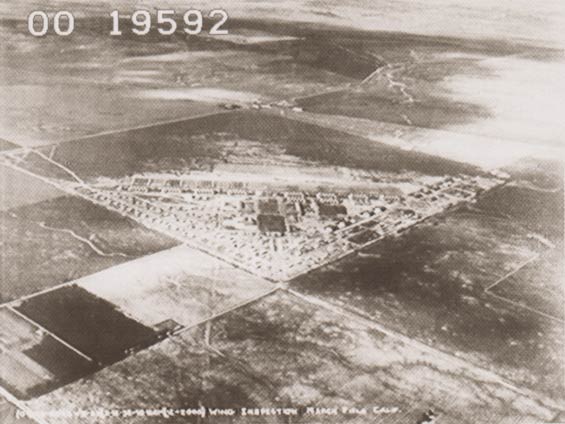 |
Below, from this REFERENCE, page 24, a description of March Field ca. 1937. Radio facilities and teletype had been added since 1931.
March FIeld, 1937 (Source: Webmaster)
 |
March Field, Overhead Aerial View, April 8, 1938 (Source: NASM)
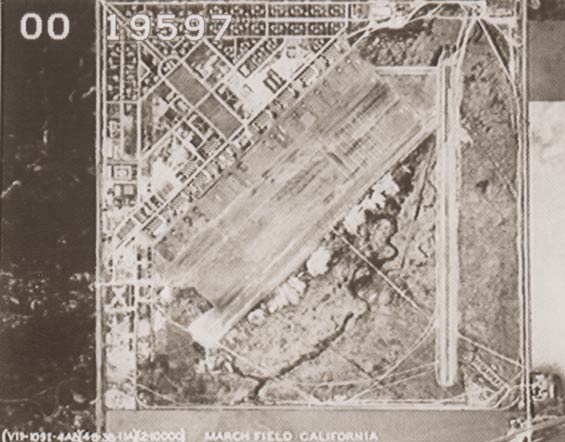 |
Three more vintage March Field aerial images, dated 1932, 1936 and 1938 are at the link in the Cosgrove Collection on this site. Today, as earlier, March Field is about 8 miles southeast of Riverside Municipal. This Google Earth image of the airfield, below, is from March 21, 2008 facing due north from about 5,900 feet.
March FIeld, 2008 (Source: Google Earth)
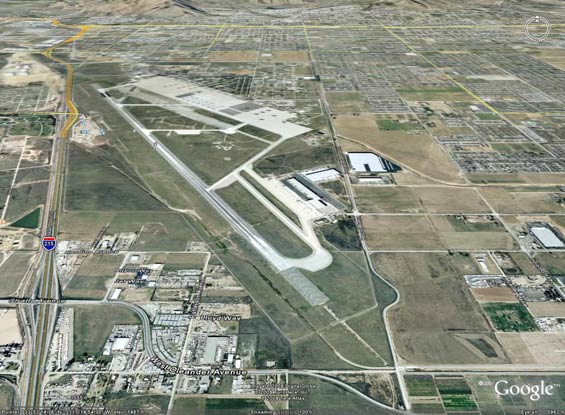 |
RIVERSIDE MUNICIPAL AIRPORT
Riverside Municipal was established in the early 1920s by a colorful Riverside citizen, promoter, raconteur and real-life "Cowboy Aviator," Roman Warren. Born in Joliet, IL April 1, 1892, Warren died at age 98 in 1991. His vignette is in the upper left corner of this page.
Riverside Municipal Airport, 1931 (Source: Webmaster)
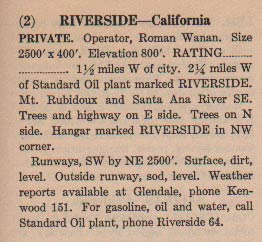 |
Warren learned to fly in the late teens, too late to participate in WWI. He used a pasture on his property near the Santa Ana River for landing his airplane, a surplus JN-4. Warren is quoted in the reference, above, "Originally, I started with 15 acres and a runway of 900 feet. Later, the acreage for airport purposes was boosted to 1000; and two runways, one for a distance of 4000 feet and the other 3000 feet, were installed to bring the airport up to government standards."
In 1926, the Riverside Commission of Aeronautics met to develop a program to establish the airport as a permanent flying field. A local newspaper reported, " Trucks, tractors, discs and drags have lately been working double time to whip the Riverside Airport in shape."
At left, from this REFERENCE, page 64, a description of Warren's airport ca. 1931. Note that his name is misspelled "Wanan." I don't have any still photographs of the Riverside Airport from this era, but you can view a moving picture film that shows the airport from the air, as well as founder Warren, at the link. This film, overdubbed and narrated by Warren later in his life, shows him flying under the Rubidoux Bridge June 14, 1926, a feat he became famous for. It also shows a Register airplane, Ogden Osprey PB NC150W. It is a film worth watching.
Below, a Google Earth image of Riverside Municipal Airport with the Santa Ana River running east-west at the north, just off the top of the photo. Riverside Municipal was dedicated in 1927 amid great festivities.
Riverside Municipal Airport, 2010 (Source: Google Earth)
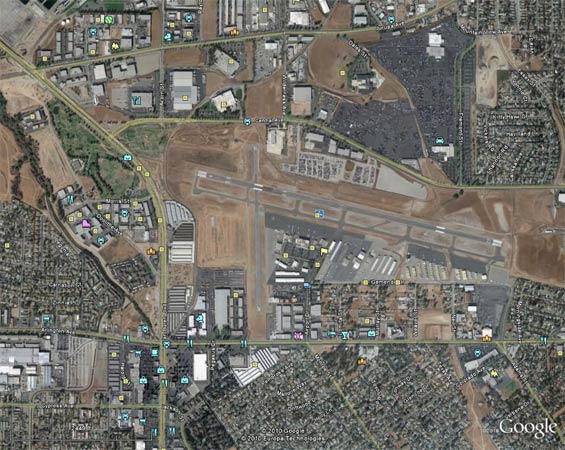 |
Contemporary Advertisement for Flabob Airport, September, 2015 (Source: SA)
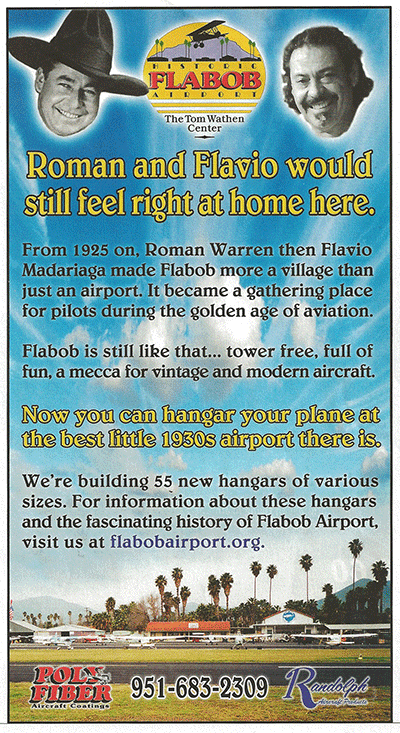 |
However, this is not the site of Warren's original field. John D. Lyon of Riverside provides the following commentary and clarification, "Warren's airport was located immediately west of the Santa Ana River and just south of a street then called 'County Road,' later U.S. 60, and now Mission Boulevard. It operated as the principal civil airport of Riverside until 1938 when it was flooded out. 1938 was a time of a great flood in California, which 'reminded' Warren and others that the airport had been built in the old west channel of the Santa Ana, which had not been occupied by the river during the twentieth century. At the same time Warren was involved in a lease dispute with the owner of the land, who in turn was involved with a Riverside City Council intrigue to turn the airport into a more lucrative racetrack. Warren left in disgust (later to become a CPT instructor and then a County Supervisor). A few of the surviving pilots moved a few hundred yards west to higher ground and continued to fly. In 1943 Flavio Madariaga and Bob Bogen bought the land and continued the operations of what was still called Riverside Airport, or sometimes West Riverside Airport. A few years later the name was changed to Fla Bob [pronounced "flaybob]." So the closest successor to Warren's Riverside Airport is Flabob, and at the east end of the field it is still possible to see the old bank of the river and the lower land on which Warren's field began.
"The current Riverside Municipal Airport above was founded as a dirt strip in the independent town of Arlington, and called Arlington Airport. Later, when Riverside annexed Arlington, it became Riverside Arlington Airport, and it was resulting confusion between it and 'Riverside Airport' which led to the creation of the name 'Fla Bob.' The distinction is perpetuated in the identifiers: KRAL for 'Riverside Arlington' and KRIR for 'Riverside Riverside.'" Above is an advertisement for Flabob airport from Sport Aviation, September, 2015. Roman Warren is at top left in the ad.
Mr. Lyon provides the following images and commentary regarding Warren's original field. The first two are taken from opposite directions, six years apart.
He states, "Here are two aerials of Riverside Airport (not Riverside Arlington Airport, the present-day Riverside Municipal), Roman Warren's airport.... [The one below] is looking east. The crossed runways of Riverside Airport are in the lower center. Note the word "RIVERSIDE" spelled out in white stones along the highway to the left; the hangar is just to the right and above that. The bridge Roman flew under crosses the river and circles around Mt. Rubidoux, with the city of Riverside beyond. You can clearly see in this photo that the ancient bed of the river included the airport. [The present day] Flabob Airport is located at lower center, and off the picture toward the viewer, just to the right of the street pattern of Rubidoux, which is higher ground."
Riverside Airport From the Air, 1932 (Source: Lyon)
 |
Mr. Lyon continues, "The second photo, [showing 1928 flooding], looks southwest. The X-pattern of the runways, covered with water, is easily discernible. A close inspection shows the hangar, just across the bridge on the south (left) side of the highway. Present-day Flabob is in the upper left on the high ground."
Riverside Airport From the Air, 1938 (Source: Lyon)
 |
The following three photos show the hangar at Riverside Airport. The first one shows the aircraft "Big Ben" and "City of Chicago" flown by the Hunter Brothers. Please direct your browser to their link for additional information and photographs of them and their historic aircraft.
Riverside Airport, 1930 (Source: Lyon)
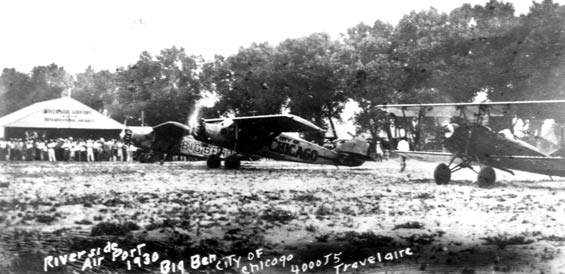 |
Below, the hangar in 1936 with Roman Warren on horseback.
Riverside Airport, 1936 (Source: Lyon)
 |
Compare these three photographs with the moving picture film linked at Ogden Osprey NC150W. Earlly in the film, you can see the Riverside hangar in the background. As well, you can see Roman Warren wearing his hat (the film is narrated by Warren) and flying his Thomas-Morse under the bridge as described above.
Riverside Airport, Date Unknown (Source: Lyon)
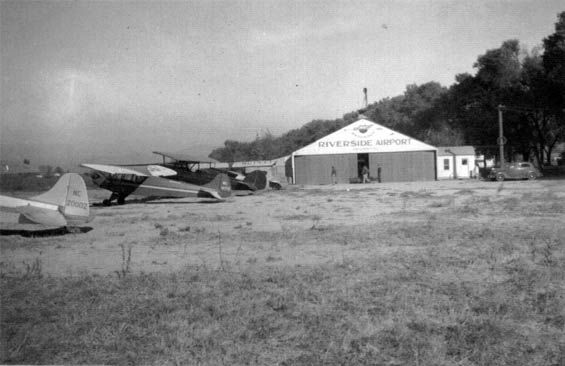 |
Warren was a popular fixture at aviation events in the 1920s and 30s. From the Bureau of Aeronautics Newsletter of March 7, 1928, below, we learn that he participated in the grand opening of the Chamber of Commerce Field at Palm Springs, CA. Warren was the "picturesque touch" with his Thomas-Morse airplane and hat. As well, the Navy from N.A.S. San Diego was represented by Register pilot W.K. Berner.
Bureau of Aeronautics Newsletter, March 7, 1928 (Source: Webmaster)
 |
---o0o---
Dossier 1.9
THIS PAGE UPLOADED: 12/2210 REVISED: 02/02/11, 02/16/11, 03/04/11, 10/25/15
|

